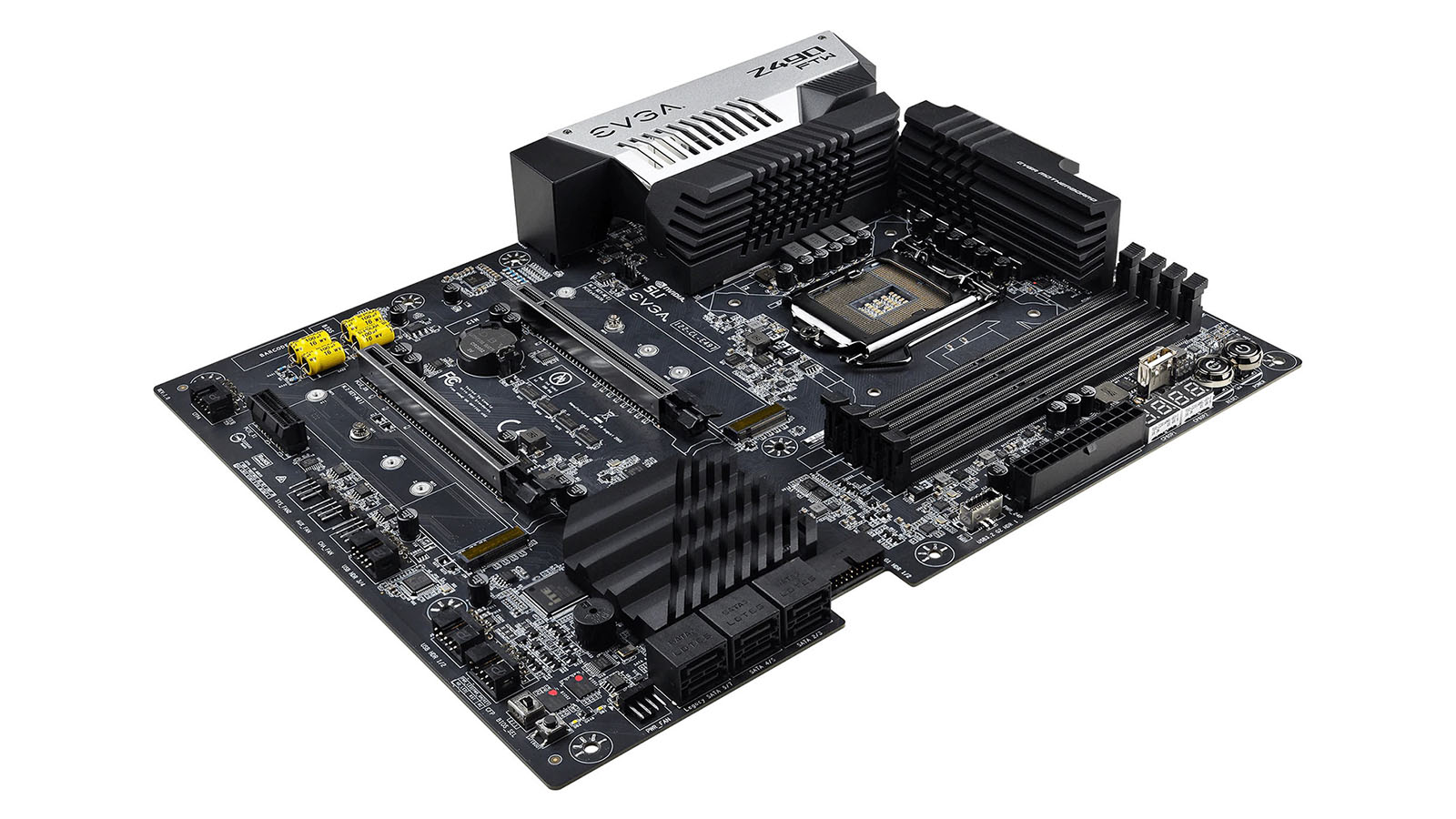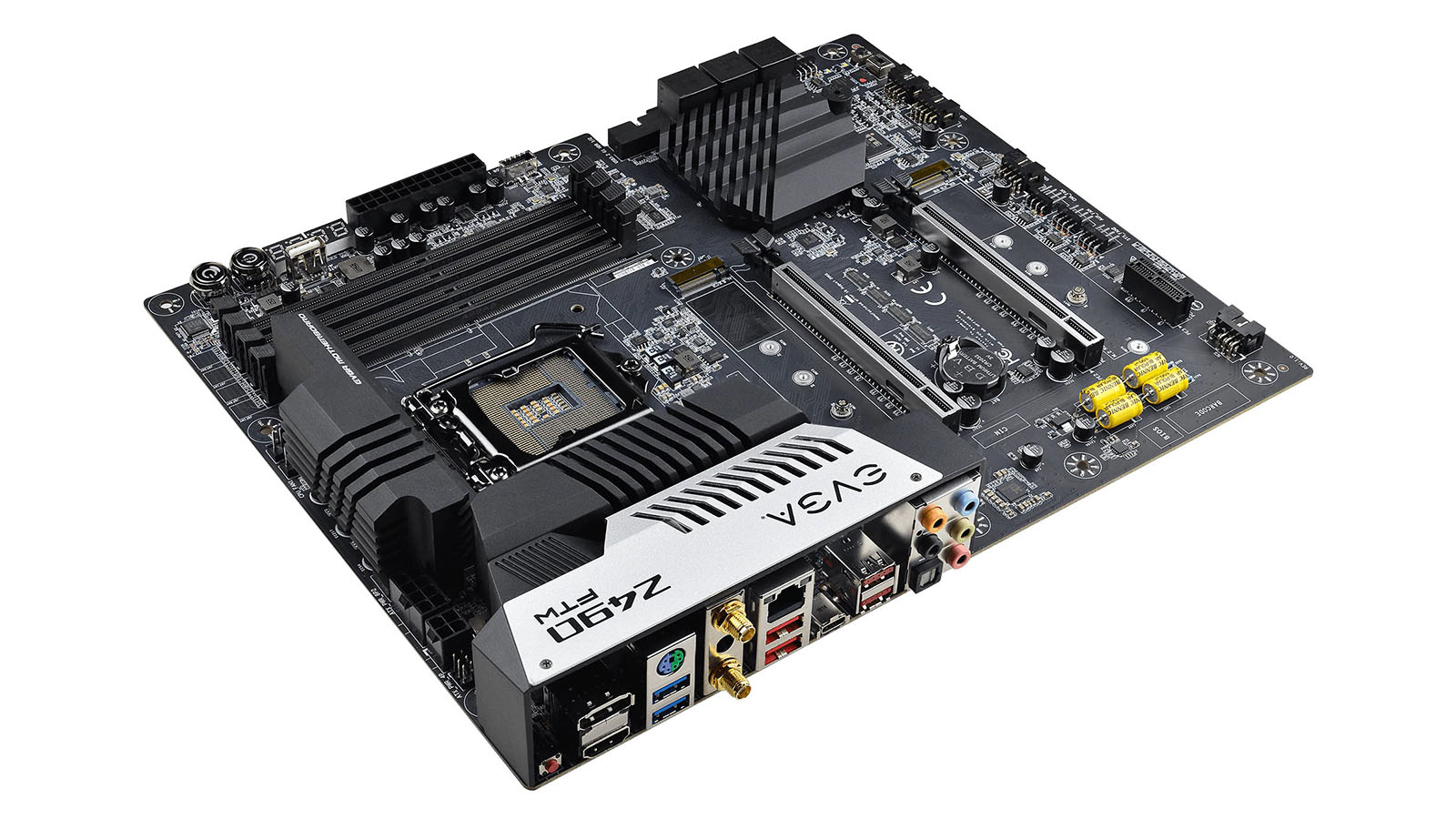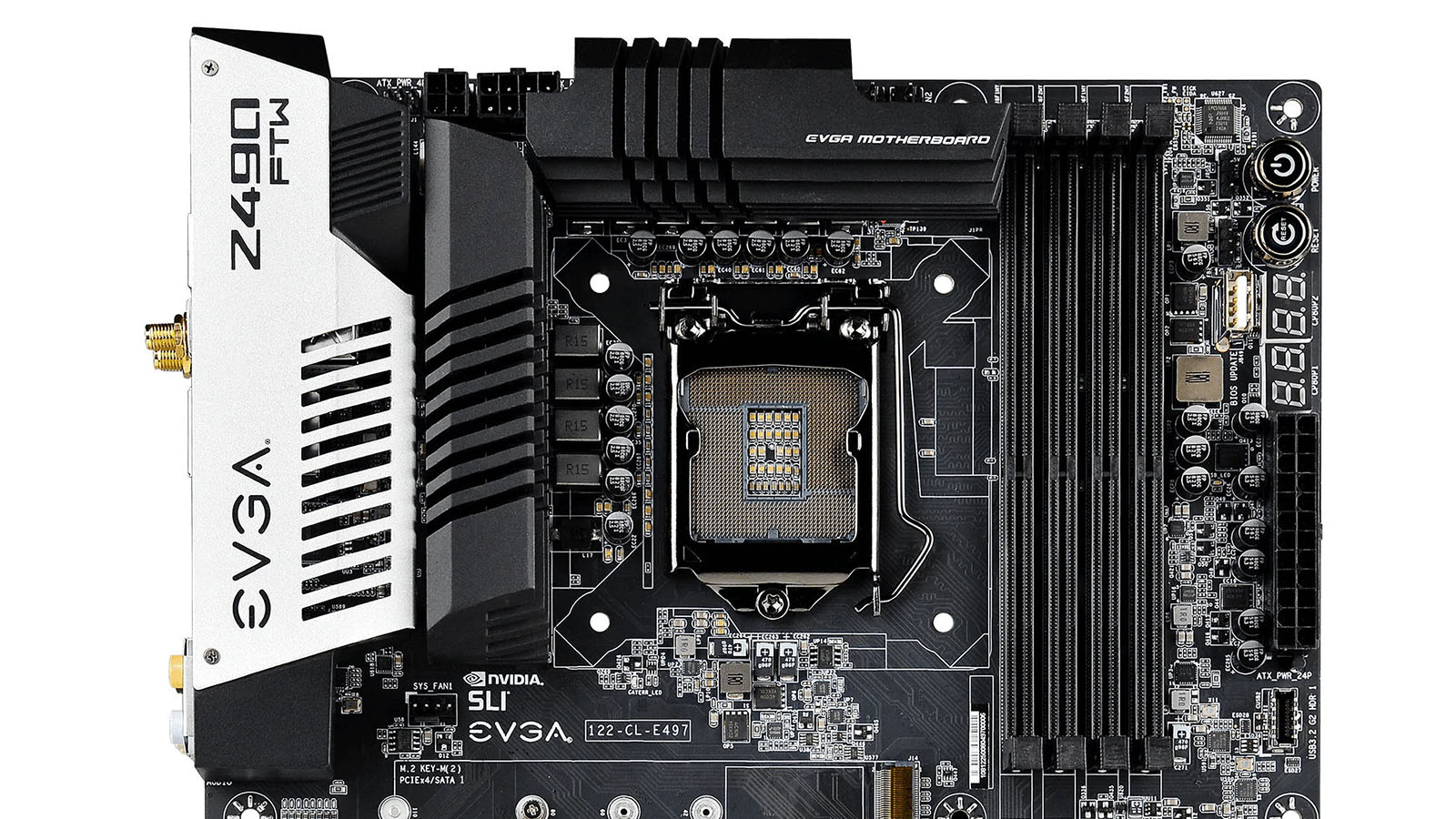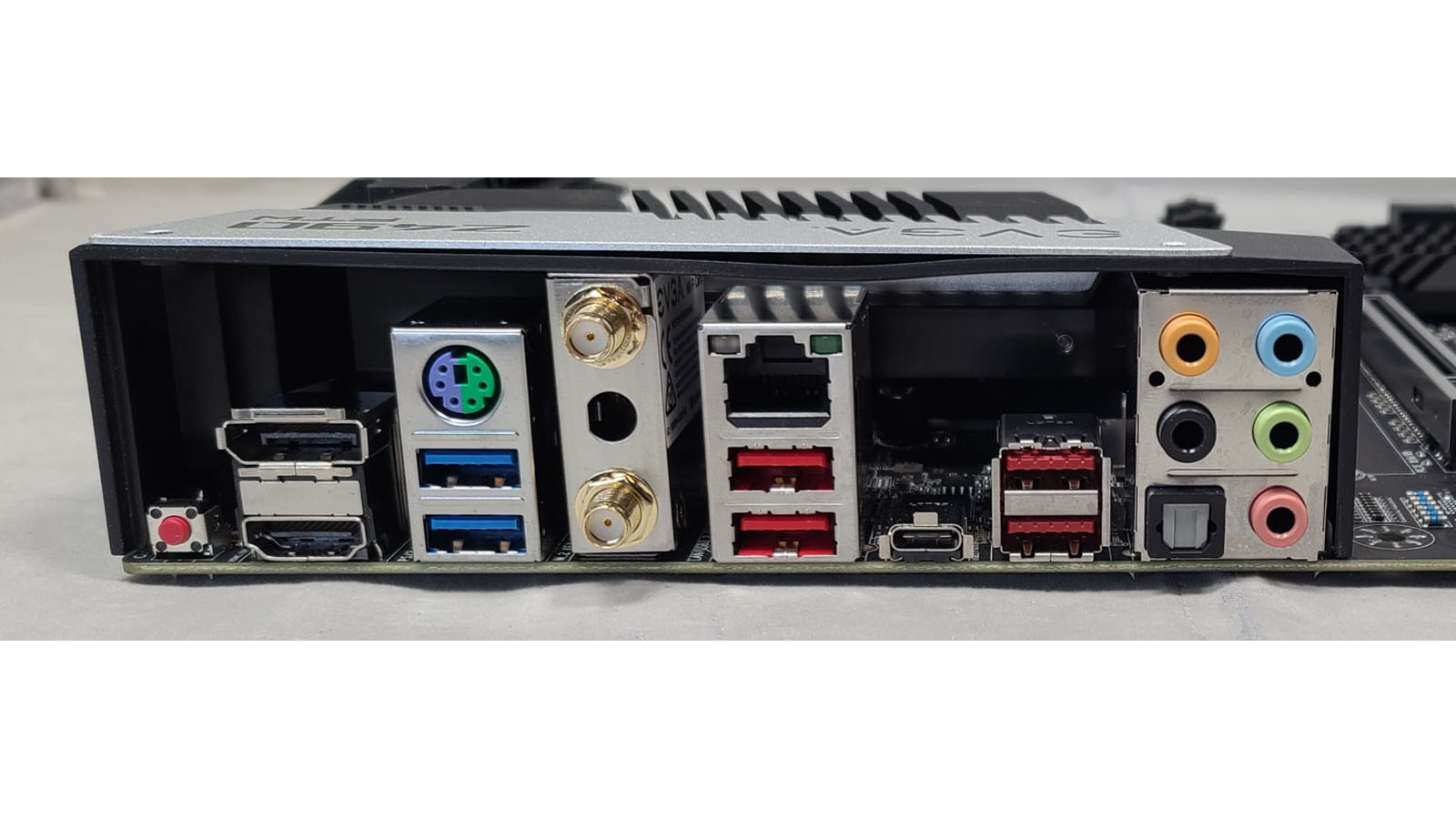Tom's Hardware Verdict
Its looks may be polarizing, but the EVGA Z490 FTW has what you need to build a solid Z490-based system. The VRMs are more than capable and the ultra-fast USB Type-C port is a plus. If you’re working on an open benching station, the onboard buttons and debug readouts are also handy.
Pros
- +
Capable power delivery
- +
USB 3.2 Gen 2x2 Type-C port
- +
Horizontal fan/USB headers
Cons
- -
Appearance can be polarizing
- -
1 Gigabit ethernet
Why you can trust Tom's Hardware
In addition to the features mentioned previously, the Z490 FTW WiFi includes Intel Gigabit LAN, six SATA ports, two M.2 sockets (neither with heatsinks), onboard power/reset buttons and seven 4-pin fan/pump headers for cooling. Below is a complete list of specifications from EVGA.
EVGA may be better known for graphics cards and power supplies, but the company has also been pushing into the motherboard realm for years, though with far fewer products than competitors like MSI or Gigabyte.The EVGA Z490 FTW WiFi that we’re looking at here sits at the ‘bottom’ of the company’s Z490 product stack, with the high-end Z490 Dark ($699.99) sitting above as the only other board on Intel’s current platform. You won’t find a Micro ATX or Mini ITX board from EVGA, just the ATX FTW and E-ATX Dark.
For $329.99 (at the EVGA store), the Z490 FTW includes a robust 14-phase VRM, Realtek and NU Audio sound, a USB 3.2 Gen2x2 Type-C port, and integrated Intel Wi-Fi 6/AX201 capabilities. All in all, it’s a well-apportioned motherboard, although its looks are somewhat raw compared to similarly priced products.
On the performance front, the Z490 FTW WiFi performed as expected, mostly blending in well with our other Z490 results. Though there weren’t any alarming differences, the board was a bit slower in some tests, but not alarmingly so. The capable VRM handled our power-hungry Intel Core i9-10900K at stock speeds as well as the 5.2 GHz all-core/thread overclock, so there’s no issues on that front.
Specifications - EVGA Z490 FTW WiFi
| Socket | LGA 1200 |
| Chipset | Z490 |
| Form Factor | ATX |
| Voltage Regulator | 14 Phase (8 Vcore) 60A MOSFETs |
| Video Ports | (1) HDMI (v1.4), (1) DisplayPort (1.2) |
| USB Ports | (1) USB 3.2 Gen 2x2 Type-C (20 Gbps), (4) USB 3.2 Gen 2, Type-A (10 Gbps), (2) USB 3.2 Gen 1, Type-A (10 Gbps), (1) USB 2.0 (update port for flashing BIOS) |
| Network Jacks | (1) 1 GbE |
| Audio Jacks | (5) Analog + SPDIF |
| Legacy Ports/Jacks | ✗ |
| Other Ports/Jack | Wi-Fi Antenna |
| PCIe x16 | Row 10 - Cell 1 |
| PCIe x8 | ✗ |
| PCIe x4 | ✗ |
| PCIe x1 | (1) v3.0 (x1) |
| CrossFire/SLI | Nvidia 2-Way SLI |
| DIMM slots | (4) DDR4 4400+(OC) |
| M.2 slots | (2) PCIe 3.0 x4 / SATA + PCIe (up to 110mm) |
| U.2 Ports | ✗ |
| SATA Ports | (6) SATA3 6 Gbps |
| USB Headers | (1) USB v3.2 Gen 2, (1) USB 3.2 Gen1, (2) USB v2.0 |
| Fan/Pump Headers | (7) 4-Pin (2 DC only, 5 PWM+DC) |
| RGB Headers | (1) Addressable RGB (3-pin), (1) RGB (4-pin) |
| Legacy Interfaces | ✗ |
| Other Interfaces | FP-Audio, TPM |
| Diagnostics Panel | Yes, 2x two-character panels |
| Internal Button/Switch | Power, Reset, Safe Boot, BIOS switch |
| SATA Controllers | ASMedia ASM1061 |
| Ethernet Controllers | (1) Intel I219-V (1 GbE) |
| Wi-Fi / Bluetooth | Intel AX201 Wi-Fi 6 (802.11ax, MU-MIMO, 160 MHz) / BT 5.1 |
| USB Controllers | ASMedia ASM1074 |
| HD Audio Codec | Realtek ALC1220 |
| DDL/DTS Connect | ✗ / Yes |
| Warranty | 3 Years |
The EVGA Z490 FTW WiFi comes with several accessories to get you started. The box includes SATA cables, installation guides, a rear IO plate, WiFi antenna, and more. Conveniently, instead of a driver disk, EVGA includes a small USB flash drive that contains all of its drivers (and the manual). I wish more partners would start doing this, as optical drives have become increasingly less common in today’s builds. Below is a list of what is included in the box in addition to the motherboard.
- EVGA Quick Installation Guide
- Rear Case I/O panel
- 2x SATA cables
- 2x M.2 thermal pads
- 2x WiFi antenna
- Case badge
- USB flash drive (drivers)



On the RGB front, the FTW WiFi includes a small strip of addressable RGBs under the right side of the chipset heatsink. The implementation is subtle, but the LEDs bright and the color is saturated. If the integrated lighting isn’t enough, the board has a 3-pin ARGB header and a 4-pin RGB header located by the power and reset buttons to attach more.
The first thing we noticed about Z490 FTW WiFi is that it bucks the trend, forgoing shrouds and other accouterments designed to cover the PCB. Other boards at similar price points tend to include more flashy shrouds and other coverings designed to pretty up the board and hide the PCB. That said, this board doesn’t look bad, with its flat-black PCB, slots, and connectors. However, some users may prefer a board with those included, especially at prices above $300.
Get Tom's Hardware's best news and in-depth reviews, straight to your inbox.

On the top half of the board, we get a closer look at the matte-black heatsinks covering both VRMs, as well as a vented silver shroud covering the IO bits. On the shroud is the EVGA branding, along with the Z490 FTW model name written in a contrasting black. Nestled between the VRM banks are an 8-pin (required) and 4-pin (optional) EPS connector for sending power to the CPU.
To the right of the socket area are four black DIMM slots with locking mechanisms on both sides. The Z490 FTW WiFi supports up to 128GB of DDR4 with speeds listed to DDR4 4400. The listed specification is lower than several other comparable boards.
Hidden just above the top VRM heatsink are two 4-pin CPU fan headers rated for 24W/2A each. Note that these two headers control fans by PWM only. The other five fan headers support both PWM and DC control, as well as the same 24W/2A output as the CPU fan headers. It’s nice to see all headers support more than the basic 12W/1A, as this yields additional flexibility for stacking fans on any header.
Located on the right edge of the board are power and reset buttons, dual 2-character debug LEDs and a vertical USB port (used for BIOS flashback purposes/easy access when on a benching table). The dual debug LEDs spin through POST codes when powered on and by default settle with temperatures. There are options in the BIOS for these to display different voltages (Vcore, DRAM, System Agent, etc) as well. For the extreme overlocker or those who plan on using this motherboard on a benching station, this can come in handy.
Last up on the top half of the board, below the debug LEDs, is the 24-pin ATX power lead for the motherboard and a front-panel USB 3.2 Gen2 header.

Moving on to power delivery, EVGA lists the VRM as 14 total phases. Power is sent from the EPS connector(s) and handled by an Intersil ISL69138 dual output, multiphase (X+Y ≤ 7) controller. Vcore consists of 8-phases using 60A Intersil ISL99227BFRZ-T single power stages. While not the most robust we’ve seen, it is certainly comparable and capable at the $300-plus price point, handling our Intel Core i9-10900K without issue, even when overclocked.

Looking at the bottom half of the board, the most prominent feature may be the huge yellow audio caps located in the bottom-right corner. These caps are downstream from the premium Realtek ALC1220 codec that’s located above the caps. We don’t see any shielding nor the distinct audio separation line here. However, the integrated audio will still be sufficient for most users.
In the middle of the board are three PCIe slots and two M.2 sockets. On the PCIe side, both slots are full-length and use metal reinforcement around the connector for EMI protection and to prevent shearing. The top slot is the primary GPU slot and works at x16. The second slot will work up x8 when the first is in use. This slot configuration supports up to 2-Way Nvidia SLI. The single x1 slot sources its bandwidth from the chipset and is located below the x16 slots. Thankfully, this slot is a usable location, compared to the layout of some motherboards where it gets blocked by graphics cards.
Around the PCIe slots are the two M.2 sockets. Both sockets support modules up to 110mm long. The top M.2 socket (M.2 2) supports PCIe 3.0 x4 (32 Gbps) devices, while the bottom slot (M.2 1), supports PCI- and SATA-based drives. The Z490 FTW WiFi does not share bandwidth with the SATA ports, as four are native and the other two are controlled by a third-party ASMedia controller.
To the right of the PCIe/M.2 area is a small chipset heatsink that houses the addressable RGB lighting found on the board. The front-panel USB 3.2 Gen 1 header is oriented horizontally and offset from the SATA ports (a ‘notch is taken out of the motherboard so it sits flush with the edge) which helps with cable management.
Just below it are three SATA ports. Four of these (the top four) are native ports, while the ASmedia ASM1061 controller supplies the other two ports. The four native ports support RAID0, 1, 5, and 10. According to EVGA, the third-party ports primarily exist for legacy OS support, mainly for benchmarking and overclocking with specific applications. That said, the board is not guaranteed to fully support any OS prior to Windows 10 x64, as EVGA (other board partners as well) doesn’t offer drivers for legacy operating systems.
Across the bottom edge are a slew of headers and ports, all of which are angled horizontally, again helping with cable management. You’ll find fan and audio ports, USB headers, and more. Below is a complete list in order from left to right.
- Front panel audio
- (3) DC/PWM fan headers
- (2) USB 2.0 headers
- Front panel connectors
- BIOS selector switch
- BIOS SafeBoot button

Flipping the board around to the rear IO, about the only thing that stands out is a lack of an integrated IO plate (though a plate is included in the accessories). At this price, I’d like to see these integrated, but do understand this is more of a purpose-built track car than it is a daily driver with luxury appointments.
That out of the way, we find seven USB ports, Two 3.2 Gen1 ports, Four 3.2 Gen2, and a single USB 3.2 Gen2x2 Type -C port. Video outputs consist of an HDMI port and DisplayPort. In addition to the 5-plug plus SPDIF audio stack, you’ll also find the Wi-Fi antenna connections, a legacy PS/2 port and a BIOS/CMOS reset button.

Joe Shields is a staff writer at Tom’s Hardware. He reviews motherboards and PC components.